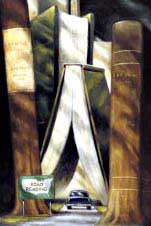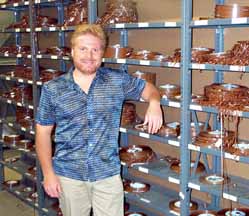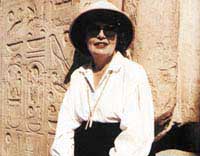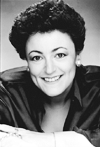|
|
 Why Hold a Book When It Can Hold You ~ Spellbound? Why Hold a Book When It Can Hold You ~ Spellbound?
with Confessions of an Audiobook Addict
by Sandra Martin
The sun is high, the water blue, the sand warm, the breeze cool and my novel great: Not only is it thrilling, it doesn’t shade me from the sun, and I can twist and turn as much as I like without losing my place. The only flaw in this timeless afternoon of beach reading is that I can’t hear the roar of the ocean over my book.
Reading through my ears, which are plugged into a pocket-sized cassette player, I’m not alone. In three decades, taped books have transformed both the art of reading and the publishing and book-delivery industries.
First of all, it’s talking books - not e-books that you’ve got to read with your eyes and hands stuck to your computer, where you’ve likely sat most of the day, as your rear widens - that have leavened book-making in recent years. Talking books have been to book publishing what Barnes & Noble has been to book buying; what Fresh Fields/Whole Foods has been to grocery shopping; what Starbucks has been to coffee drinking. Stories read by human voice onto cassette have returned necessity to adventure. They’ve made reading a comfortable, portable, addictive adventure.
“We’re the fastest growing entertainment medium in the country,” Audio Publishers Association president Eileen Hutton told me. Annual sales of talking books topped $2 billion even before the century turned. Now, close to a quarter of American households harbor a talking-book reader.
To satisfy those readers, librarians have filled new shelves with talking books. “Since the mid-1980s, we’ve watched these things get more and more popular,” says Anne Arundel County librarian Ed Epstein, who bought talking books for that 15-library system throughout the 1990s. “People vote with their library cards, and they were voting for audio books.” Of Anne Arundel’s 1.3 million-item collection, three percent now talks. At 2.7 percent, the Calvert County library system is keeping pace.
“Are we typical?” ponders Epstein. “In Maryland we are. The growth has been dramatic.”
Accounting for 10 percent of sales, talking books have been a boon to the book-publishing industry. “Even when book sales are down, audio is up,” says Hutton.
“Today most books with printings over 100,000 are also published in audio, along with many with significantly smaller printings,” reports Brian Downing, editor in chief of Recorded Books.
That’s a conservative reading of demand, according to Epstein. “It’s come to the point now, that when there’s a new book title in fiction, people expect an equivalent audio book title,” he says.
Tracking down the next talking book you’ll read has become an industry of its own. Dozens of web sites offer help, while in print the two-volume, 4,377-page reference guide Words on Cassette lists 85,000 titles.
Nowadays, millions of readers use their ears as often as their eyes to devour books. We can now read when we’re driving a car, waiting out a traffic jam (where the average American now spends 36 hours a year), riding Metro, cleaning the house, running a track, even — without spoiling the print — while taking a bath.
“The appeal of the industry is people’s busy lives,” Hutton explains. “They’re busy doing things that don’t allow them the leisure of sitting and reading. Audio books let them keep reading while they’re doing other things.”
Artists listen in the routine parts of their work. Truck drivers on the open road listen. Crabbers on Chesapeake Bay listen.
One talking book reader, Nina Jaffe of Florida, wrote that she “wanted to listen to a Recorded Book during [her] C-section … what a relaxing way to deliver a baby that would’ve been!”
Confession
But you’ve got to allow for the noise that a talking book makes. Read by George Guidall, one of the full-throated star narrators of talking books, Tony Hillerman’s Hunting Badger (a bestseller in Recorded Books’ 2001 list) is so loud it drowns the ocean out. Who knows if the story is spilling out of my earplugs so that other sunbathers are reading over my shoulder.
I have been asked to turn down my talking book, but that was another summer when, as I canned tomatoes into the night, my book blared through stereo speakers out the open windows — until sleepless neighbors banged on the door.
Maryland: Action Central
Audio publishing has followed something of the curve of the Gold Rush. In the beginning was a resource crying out to be exploited. In mid-19th century California, it was gold. In late-20th century America the resource was idleness. More specifically, enforced highway idleness.
“My territory ran from Delaware to North Carolina,” recalls Henry Trentman who in 1974 came to Southern Maryland from Delaware as a manufacturer’s rep. “That’s a lot of driving.” Desperate for “a way to occupy” himself on the road, he made tapes of old records and radio shows.
Thus was conceived Recorded Books — a native Maryland company — and many others like it. The story is about the same for Southern Californian Duvall Hecht, whose company, Books On Tape, got a four-year jump on Recorded Books.
“Hecht got the idea in 1973, during the drive from his Newport Beach home to his Los Angeles office,” reports the Orange County Register. “Weary of the radio’s drone, he thought: Wouldn’t it be great to listen to a book? A full-length recording of a book?”
Hundreds of book-loving entrepreneurs have since sought their fortunes in talking books. Rifle through a box of talking books or the shelves of a second-hand bookstore, and you’ll find their legacy. Mom-and-Pop start-ups headed for the hills along with publishing giants Random House, Bantam Doubleday Dell Publishing Group, Simon & Schuster, HarperCollins and Time Warner.
Some struck gold. By the end of the century, BDD Audio was adding some 15 to 20 percent to the average annual sales of Bantam Doubleday Dell. Among independents, Books On Tape reported annual revenues over $10 million. Recorded Books will say only that their sales were “extraordinary.”
More struck out or are still panning.
Among the handful of small publishers searching for the big strike is Commuter’s Library, of Fairfax, Virginia. For nearly 10 years, founder Joe Langenfeld has worked a narrow niche in the audio book market, producing affordable, finely engineered two-tape editions of unabridged classics for individuals and libraries. The format has worked well enough for Langenfeld to expand the original Commuter’s Library line from just two offerings (James Joyce and Anton Chekov) to dozens, including CD versions of the King James’ Bible, classic radio programs and World War II recordings. Despite rave reviews, publishing awards and on-line ordering, Commuter’s Library struggles to maintain its stake amid the giants.
For audio 49-ers, success isn’t easily or cheaply mined.
A few years after his bright idea, Recorded Books’ Trentman built a studio atop his farm in Clinton, where helicopters from Andrews Air Force Base interfered with the recording quality. But there was good luck as well as bad. From Arena Stage, he recruited actor Frank Muller as a reader; for books with women narrators, he got Flo Gibson, then a reader for Library of Congress. “They,” he says, “set the standard” — not only for his new company but for the craft. Muller, who’s still reading, has become a star.
Still, Trentman recalls the “learning process” as slow. The first book, Jack London’s Seawolf, took a year. It was, Trentman says, “a favorite of mine — and in the public domain,” so he’d have no copyright to negotiate, no royalties to pay. The first year produced five books.
“For the first 10 years, when I was putting in 70-to-80-hour weeks, I was glad I’d kept my day job,” says Trentman today.
In the long run, Trentman’s hunch proved right. Attests librarian Pat Hofmann, whose Calvert County Library system is a regular buyer of Recorded Books: “People come in and say ‘This makes my commute bearable. Because of audio books, I can stand to drive for two hours each way.’”
So, Trentman allows, the next 10 years were “very successful.”
 Confession Confession
photograph:from Recorded Books website
Admittedly, I was a newcomer. For a Midwesterner, landing in Chesapeake Country was like blundering into heaven. Still, in the couple of years I’d lived on the Anne Arundel-Calvert County line, I hadn’t discovered much reason to think of Calvert County as progressive.
Back then, the county had one stoplight and one nuclear power plant. Tobacco grew in fields where sharecropper homes still stood. Farmers traveled the roads on tractors new before World War II. There wasn’t even a McDonald’s. Not that I was complaining.
On the other hand, Calvert had some extraordinary oases: fast and wide, Route 2-4 was surely going someplace (15 years later, we’ve found where: to build-out). The County’s plan for its future growth won the praise of the American Planning Association. Calvert County had Vera, whose Polynesian palace at White Sands on St. Leonard Creek was surely no backwater. And Calvert County had Recorded Books.
Now that my neighborhood was measured by counties, not by blocks, I had discovered that talking books made my various commutes whiz by, even when traffic wasn’t. I don’t remember the name of the first talking book I devoured. I do remember that I checked it out at the Twin Beaches Calvert County Library, then in North Beach.
Soon I noticed that the books I liked best — full-length novels read by compelling narrators — came packaged nice and solid in hard-cover, plastic ‘books’ that didn’t fall apart in your lap. Neither did the tapes spew out of the recorder ensnaring the gear shift — and leaving me down at St. Leonard’s Creek without a book.
Eventually, I got around to reading the label. These were Recorded Books, typified by the cute logo of a smiling man in headphones. The early books, I learned on both the cover and on audio ordering instructions at the beginning and end of each tape, came to me from Charlotte Hall.
‘Hey, that’s across the Patuxent down Route 5,’ I said to myself in surprise. Another surprise was in store. The next time I looked, the address said Prince Frederick.
‘Hey, I said to myself, ‘what’s a company like that doing in a place like this?’
Striking Rich in Calvert
You expect a publishing house to be in New York. You expect brick-and-mortar canyons where the light filters way down. You expect overachievers who talk as fast as they walk. Stars and starlets, you expect, revolve around a bright sun.
So what’s Recorded Books doing in Calvert County? Not even in Prince Frederick, mind you, but down Route 231 in the Industrial Park on the way to the Patuxent River?
The answer: striking it rich. By the mid-1980s, the young company had outgrown its farm loft.
Meanwhile, Calvert, a one-industry county, was eager to increase employment and diversify its economic base beyond its nuclear power plant. Plus, being a peninsula between Chesapeake Bay and the Patuxent River, the county wanted to keep growth clean. In the mid-1970s, the county, hoping to draw nice, clean businesses, had built an industrial park down a remote road.
Between 1975, when the county sold the first industrial park space to C&P Telephone, and 1981, when the next tenant, Direct Mail, came in “it kind of sat there,” recalls Shirley Whittington, a long-time staffer with the Calvert County Department of Economic Development. “When Recorded Books came in 1987, the park was still in its early stage.”
Recorded Books was willing, and it was nice and clean. “They use people’s minds rather than manufacture a big product with lots of by-products,” says County business development director Jim Shepherd.
In Calvert’s industrial park, Recorded Books set up corporate housekeeping. There the publishing took place, with all its buying and selling, copy writing and editing, publicizing and promoting, tape copying and mailing.
Truth be told, by then part of the publishing house had indeed moved to New York. In that artistic Mecca, Trentman and his then-partner Alex Spencer set up the studio that enabled them to produce in volume. There they enthroned Claudia Howard, who remains their studio director, recruiting and recording the talent that has remained a hallmark of Recorded Books.
By the time the company sold to Trentman Haights Cross Communications of White Plains New York in 1999, Recorded Books had, by its own report, grown into the world’s largest publisher of unabridged audio books in terms of current annual output, with 4,000 titles narrated in English, taped and distributed throughout the United States and United Kingdom. Next, Recorded Books will be talking in Spanish. Since 1999, it’s also been pressing CDs, which now account for 20 percent of company sales.
Recorded Books’ growth is a county phenomenon, as well. “With its 175 or so employees, in size it’s exceptional,” says Shepherd. “You could count on two hands the number of employers that big in the county. It’s more than five but less than 10. And they’ve just expanded onto a double lot with a 34,000-square-foot addition.”
Prince Frederick may not be New York, but Recorded Books has made it a place of distinction. Writers and researchers are drawn from Washington, Annapolis, St. Mary’s County. “The work there is not the kind of job available in many other places around Southern Maryland,” says Shepherd. “We don’t have many businesses that bring people commuting here from other places. We’d like to have another half dozen.”
The People behind the Books
You find all kinds at Recorded Books, which is, in diversity, a miniature of modern Calvert, Maryland’s fastest growing county.
One of the commuters is editor and new father Brian Downing, 37, who drives down from Georgetown. He’s in charge of acquisitions and the team that scans thousands of the 200,000 books published in America each year to choose the 500 his company will record.
Driving from St. Mary’s County is writer Dave Phalen, 38. A former community college teacher of English and writing, Phalen was lured by a newspaper ad to Recorded Books, where he now makes his living reading books. But the books he reads are full of mistakes. In Recorded Books’ haste to get new talking books to waiting readers, he must write cover and catalogue text from print publishing houses’ first uncorrected imprints. The copy he writes is, of course, error free.
Brian Sweeney, 29, director of agent acquisitions, commutes from Annapolis in a circuit that often takes him to New York, where he chats up agents and actors. A graduate of Marian College in Indiana, he’s found a niche where his studies in 20th century American literature and the evolution of the novel fit just fine. Sweeney started as a sales rep in the Indiana territory, lured by an ad baited with two of his favorite pleasures: talking to people and reading books. In “five or six months,” he recalls, “the president of the company, who’d noticed I was a ‘book person,’ approached me.” Which is how Sweeney and his pregnant wife left Indiana, their home of 30 years, for Chesapeake Country.
 From DuPont Circle commutes John Alexander, the 33-year-old red-headed director of consumer sales and marketing. Alexander has followed Recorded Books, where he too, started, as a sales rep, from California to England and Europe to Australia and New Zealand to D.C. From DuPont Circle commutes John Alexander, the 33-year-old red-headed director of consumer sales and marketing. Alexander has followed Recorded Books, where he too, started, as a sales rep, from California to England and Europe to Australia and New Zealand to D.C.
But sales rep Matt Walker, who sells to libraries in a three-state region, drives to work from just up the road in Huntingtown. Library sales have been Recorded Books’ bread and butter from the beginning. Anne Arundel, for example, orders multiple copies of every book Recorded Books tapes each year. All the bigger branches get their own copies. The smaller branches share.
Confession
I’ve never bought a talking book, though I’ve read hundreds. I’ll still buy hardbacks; sometimes even of new books I just want to try. When I see a new title by a favorite on the shelf, or when my appetite has been whetted by a review, I don’t have the patience to wait until it turns up in the library.
So I’ll pay $25 to Barnes & Noble or Borders for each new Tony Hillerman novel, but I wouldn’t think of paying $29.95 for the tape or $46 for the CD of Hunting Badger. I’ll wait until I come across it at the library, checking it out and listening even if I’ve got the hardback at home gathering dust after one reading.
I use my library for chance encounters, and with talking books I’m more willing to take risks. I’ve found some of my favorite partners, like Pat Barker, that way, usually on tape.
I’m one of the reasons libraries are big business for Recorded Books.
The jam is spread on company bread by people like Customer Service manager Debbie Kalnoskas, 45, of Barstow, who works the phones to help match rental customers to the right book. Kalnoskas could walk to work — were not Route 231 buzzing with commuters, who knows how many plugged somatically into a talking book.
When her husband retired from naval intelligence, the family moved to Calvert County. Kalnoskas started at Recorded Books nine years ago, working nights. Moving up the ladder, she makes sure all Recorded Books’ customers are satisfied. Kalnoskas loves her job and knows her repeat customers, like Sally in San Francisco, by name and taste.
Rental customers get their books by mail and have 30 days from the postmark date. Renting Hunting Badger costs $11.50.
In New Yorker Barbara Rosenblat’s view, Recorded Books down in Prince Frederick, Maryland, is populated by “many people making sure the tapes don’t fall out and the books melt on your windshield.”
n Chesapeake Country, where the Bay’s sprinkled beaches are the reason we commute, we know there’s a lot more going on inside those durable plastic covers.
 Look Who’s Writing Look Who’s Writing
Author, Barbara Mertz
photograph:from Recorded Books website
Recorded Books didn’t make its fortune off Jack London. Authors - which the Association calls “producers” - had to be lured with their stories to this, rather than another publishing house, and rewarded with royalties, just as in print publishing.
A thousand or so authors have thrown in their lot with his company, Recorded Books’ editor Brian Downing estimates. Some have added just one book to Recorded Books’ 4,000 titles. Others have added dozens. Their Top 10 reads like a roster of popular fiction’s big names. In addition to Tony Hillerman, they record Lilian Jackson Braun, Elmore Leonard, Dick Francis and Patrick O’Brien.
Not to mention the prolific Elizabeth Peters et. al., who we’ve been seeking since her omission from last year’s Bay Weekly summer reading special, “Literate in Maryland” [Vol. VIII No. 27: July 6-12, 2000], provoked reader Denise Pritchett of Bowie to lament:
So why have you left out [one] of Maryland’s most prolific authors? Under the name of Elizabeth Peters, Barbara Mertz, who lives near Frederick, writes the humorous historical mysteries about Amelia Peabody. She also writes supernatural mysteries as Barbara Michaels. She has also written about archeology as Dr. Barbara Mertz. This award-winning author deserves to be on any list that includes authors who can write with clarity and skill.
The woman we met at Recorded Books’ expansion gala didn’t look like a split personality, but neither did she look like either a calculating murderer or an Egyptologist. Looks can be deceiving, for Mertz is indeed all of those.
Egyptology, Mertz told me, was her early love. Born in Southern Illinois, where Cairo is known as a worn-down river town, she might never have discovered Egypt had not her family moved to Chicago, where she was near a world-class collection of Egyptian art at the Oriental Institute and earned a Ph.D. at the University of Chicago.
Thus her early writing was scholarly. Treatises might have been her life, had a woman with a Ph.D. been able to get a good job in the 1950s. When her then-husband took a job in Washington, D.C., she turned her talent and her expertise to fiction.
“When I sold my first mystery,” she recounts, “my publisher and my agent said I should have another name. I was so happy to get a book published that I didn’t care.”
‘Barbara Michaels’ wrote over two dozen novels of suspense and romance. After the second, ‘Elizabeth Peters’ - named for Mertz’s two children - wrote her first Egyptian mystery. Soon each writer was turning out a novel a year.
“As a single mother,” Mertz explains. “I had to make a living.”
Before the conversation can turn to the hard row women have had to hoe, Mertz laughs. “Life is hard enough. I look on the bright side,” she says. “I’m an optimist unless I have a cold.”
How could a nice woman like Mertz commit so many murders?
“Murder is very relaxing,” the author replies. “Writing and reading about it is how we get it out of our system.”
 Look Who’s Talking Look Who’s Talking
Narrator, Barbara Rosenblat
photograph:from Recorded Books website
“We like to have patrons hear from their author,” Brian Downing says, and some Recorded Books are indeed read by their authors. But most authors are not their own best readers. Which is why one of the richest of Recorded Books’ partnerships has been the team of the two Barbaras.
That’s Barbara Mertz, the author, and Barbara Rosenblat, her narrator, who is described by Library Journal as “the standard against which others must be judged.”
Hearing her persuasive voice, you realize why talking books have struck it rich. They’ve made portable packages out of one of life’s great pleasures: hearing a story.
You want to close your eyes and melt into the words. You can, for your ears supply you a sweet stream as sensual as warm sun or silk water. That’s okay as long as you’re at the beach. But if you’re driving a car or painting a wall, you’d better keep your eyes open.
As I wrote these words, I was listening to Rosenblat in the flesh, at the May opening of Recorded Books’ expansion in Calvert County’s industrial Park. Which is nice, but that’s icing on an already rich cake. Including 18 Peters and eight Michaels, I can hear Rosenblat’s chocolate voice on my choice of 140 audio books.
She’s talked them all in Recorded Books’ soundproof booths in its Manhattan studios. So high is their quality, she deadpans, “I can hear my biological clock ticking, and that’s got a quartz movement.”
In fact, once Rosenblat is in the booth, she settles down for three hours of hard work. Each recording segment yields roughly one and a half hours of “stock.”
She’s at work before she enters the booth. “I certainly do read each book ahead,” she says. Once she’s signed on for a book, she takes it home to read until, she says, “the palate that will serve the author best occurs to me.”
Palate in Rosenblat’s art means characters, defined by accents, inflections and pacing. “Over the years, I’ve learned to flip from character to character. It’s been a habit of mine since I was a kid.
“I would read to people in parks whether they wanted me to or not,” she says, proving her point in voices.
In decisions of characterization, the two Barbaras work together. “In her praise, she calls me on characterization and pronunciation of words,” says Mertz-Peters.
Narrators go still further to get it right. Rosenblat credits Recorded Books’ head of research Paul Topping with “demanding your list:
“‘Don’t trust to faith on how that’s pronounced,’ he says. ‘On some we’ll go to a librarian … to Internet … to an airline … to the local barkeep.’
“‘For you may live in Beauford, but I live in Boford.’”
That’s a standard of care and correctness appreciated by librarians as well as authors. “When they did James Joyce’s Ulysses,” says Anne Arundel County’s Ed Epstein, “they had linguists on board to set the pronunciation standards. This is the extraordinary care this company takes.”
Every book lover wants to get paid for reading books. How do you come by the job of reading them out loud?
“A basic background in literature and oral interpretation,” is a good start, Rosenblat advises. Earlier generations of narrators pieced together the qualities that transform reading into performance. For wannabes of the newer generation, the Audio Publishers Association (www.audiopub.org) offers seminars. Practice in a studio, the star narrator advises, to “actually hear yourself speak.” Even so, Recorded Books will do four or five hundred auditions to settle on two to four narrators.
Who will eventually settle down in one of Recorded Books’ “wildly expensive studios” to read a good book and create “a whole other world.”
Which is how, in part, a talking book transports its reader to their own other world.
“Audio takes on a life of its own,” says editor Downing. “With print and words, it’s greater than the sum of its parts.”
Copyright 2001
Bay Weekly
|